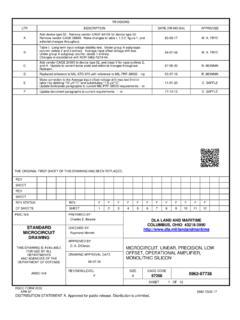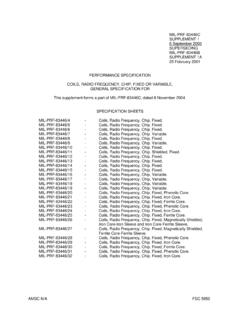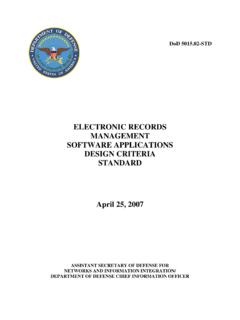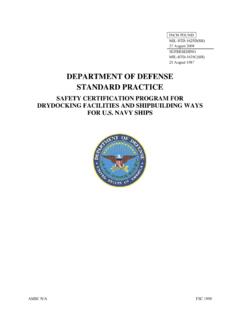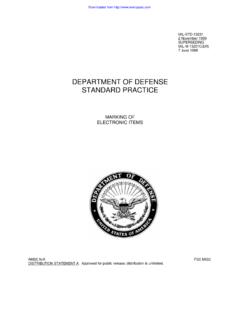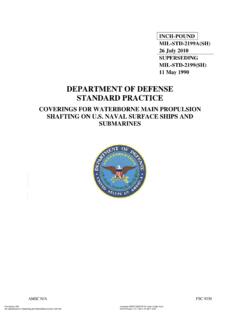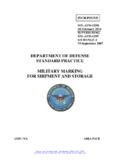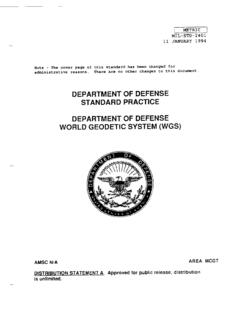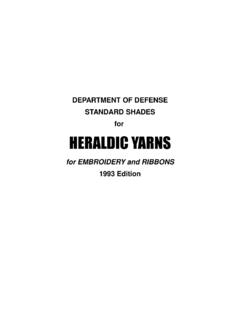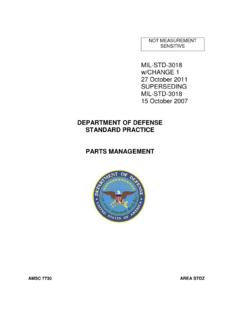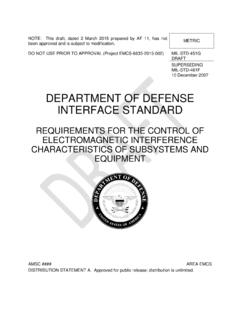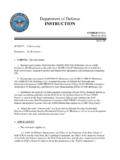Transcription of DEPARTMENT OF DEFENSE STANDARD PRACTICE
1 NOT MEASUREMENT SENSITIVE MIL-STD-790G w/ CHANGE 2 28 March 2018 SUPERSEDING MIL-STD-790G w/ CHANGE 1 24 January 2013 DEPARTMENT OF DEFENSE STANDARD PRACTICE ESTABLISHED RELIABILITY AND HIGH RELIABLITY QUALIFIED PRODUCTS LIST (QPL) SYSTEMS FOR ELECTRICAL, ELECTRONIC, AND FIBER OPTIC PARTS SPECIFICATIONS AMSC N/A AREA 59GP MIL-STD-7 90G w/ CHANGE 2 FOREWORD 1. This STANDARD is approved for use by all Departments and Agencies of the DEPARTMENT of DEFENSE . 2. In implementing the Parts Specification Management for Reliability Report (PSMR-1), issued by the DEPARTMENT of DEFENSE in May 1960, it was determined that a manufacturer must provide evidence of (a) adequate production and test facilities, and (b) sound procedures for process control. This STANDARD was developed to provide guidelines.
2 3. Comments, suggestions, or questions on this document should be addressed to: DLA Land and Maritime, ATTN: VAT, Post Office Box 3990, Columbus, Ohio 43218-3990 or by email Since contact information can change, you may want to verify the currency of this address information using the ASSIST Online database at ii MIL-STD-7 90G w/ CHANGE 2 SUMMARY OF CHANGE 2 MODIFICATIONS 1. Paragraph , replace Non-Government organization TECHAMERICA with SAE INTERNATIONAL . 2. Paragraph , SAE INTERNATIONAL, parenthesis note; delete or from TechAmerica , 601 Pennsylvania Ave, NW, North Building, Suite 600, Washington, DC 20004, and replace with . 3. Paragraph , INTERNATIONAL ORGANIZATION for standards (ISO), parenthesis note; delete or from the American National standards Institute, 11 West 42nd Street, New York, NY 10036 . 4. Paragraph , NATIONAL CONFERENCE OF standards LABORATORIES (NCSL), parenthesis note; delete or from the National Conference of standards Laboratories (NCSL) International, 1800 30th Street, Suite 305, Boulder, CO 80301-1026.
3 5. Paragraph , added definition Government-Industry data Exchange Program (GIDEP). 6. Paragraph , delete EIA-557 and replace with SAE-EIA-557 . 7. The following modifications to MIL-STD-790G have been made: PARAGRAPH MODIFICATION Changed Added Changed iii MIL-STD-7 90G w/ CHANGE 2 CONTENTS PARAGRAPH PAGE FOREWORD ii 1. SCOPE 1 Scope 1 2. APPLICABLE DOCUMENTS 1 General 1 Non-Government publications 1 Order of precedence 2 3. DEFINITIONS 2 4. GENERAL REQUIREMENTS 5 General 5 Validation 5 Elements 5 5. DETAILED REQUIREMENTS 5 General 5 Key personnel and organizations 5 Test facilities 5 Government-Industry Data Exchange Program (GIDEP) alerts 5 Sub-assembly facilities 6 Distributors 6 QPL system elements 7 Training 7 Calibration 7 Proprietary processes and procedures 7 Failure and defect analysis system 7 Failure reporting 7 Failure and defect analysis 7 Failure and defect analysis capabilities and facilities 8 Corrective action 8 Production of prototype parts for evaluation 8 Clean rooms 8 Description of production processes and controls 8 Acquisition and production control system 9 Statistical process control 9 Acceptance criteria for incoming materials and work in-process 9 Handling and packaging procedures 9 Materials 9 Incoming, in-process.
4 And outgoing inventory control 9 Conforming materials 10 Nonconforming materials 10 iv MIL-STD-7 90G w/ CHANGE 2 CONTENTS PARAGRAPH PAGE Material traceability 10 Product traceability 10 Certification of conformance and acquisition traceability 11 Controlled storage area 11 Quality assurance operations 12 Manufacturer s self-assessment system 12 Record retention 12 Records to be maintained 12 Computerized records 12 Altered records 12 Technology Review Board 12 6. NOTES 12 Intended use 12 Subject term (key word) listing 13 Changes from previous issue 13 APPENDIX A SCOPE 14 Scope 14 APPLICABLE DOCUMENTS 14 GENERAL 14 Self-assessment program 14 Self-assessment representatives 14 Deficiencies 14 Follow-up 14 Schedules 14 Self-assessment results 14 Self-assessment requirements 14 v MIL-STD-7 90G w/ CHANGE 2 APPENDIX B SCOPE 17 Scope 17 APPLICABLE DOCUMENTS 17 REQUIREMENTS 17 Technology Review Boards (TRB)
5 Levels of responsibilities 17 Purpose of TRB 17 Level 1 TRB 18 Level 2 TRB 18 TRB 18 TRB organizational structure 18 TRB responsibilities 19 TABLES B-I TRB Authority Levels 17 CONCLUDING MATERIAL 20 vi MIL-STD-7 90G w/ CHANGE 2 1. SCOPE Scope. This STANDARD is for direct reference in established reliability and high reliability electrical, electronic, and fiber optic parts specifications and establishes the criteria for a manufacturer s qualified product system. 2. APPLICABLE DOCUMENTS General. The documents listed in this section are specified in section 3, 4, or 5 of this STANDARD . This section does not include documents cited in other sections of this STANDARD or recommended for additional information or as examples.
6 While every effort has been made to ensure the completeness of this list, document users are cautioned that they must meet all specified requirements of documents cited in section 3, 4, or 5 of this STANDARD , whether or not they are listed. Non-Government publications. The following documents form a part of this document to the extent specified herein. Unless otherwise specified, the issues of these documents are those cited in the solicitation or contract. * SAE INTERNATIONAL SAE-EIA-557 -Statistical Process Control Systems * (Copies of these documents are available online at ) INTERNATIONAL ORGANIZATION for standards (ISO) ISO 10012 - Measurement Management Systems Requirements for Measurement Processes and Measuring Equipment ISO 14644-1 - Cleanrooms and Associated Controlled Environments Part 1: Classification of Air Cleanliness ISO 14644-2 - Cleanrooms and Associated Controlled Environments Part 2: Specifications for Testing and Monitoring to Prove Continued Compliance with ISO 14644-1 * (Copies of this document are available from ) NATIONAL CONFERENCE OF standards LABORATORIES (NCSL) NCSL - Requirements for the Calibration of Measuring and Test Equipment.
7 * (Copies of this document are available from ) 1 MIL-STD-7 90G w/ CHANGE 2 Order of precedence. Unless otherwise noted herein or in the contract, in the event of a conflict between the text of this document and the references cited herein, the text of this document takes precedence. Nothing in this document, however, supersedes applicable laws and regulations unless a specific exemption has been obtained. 3. DEFINITIONS Assembly plant. A plant established by a manufacturer or operated by a distributor authorized by the manufacturer to perform specified functions pertaining to the manufacturer s identified qualified products in accordance with specified assembly procedures, test methods, processes, controls, and storage, handling, and packaging techniques.
8 Burn-in (pre-conditioning). Process of subjecting components to conditions (temperature extreme, power input extremes, etc) with the intent to either stabilize performance or significantly reduce latent defects. Calibration. A comparison result between a measuring device and a known STANDARD . Clean rooms. A clean room has a controlled level of contamination that is specified by the number of particles per cubic meter at a specified particle size. Corrective action. A documented design, process, procedure, or materials change implemented and validated to correct the cause of failure or design deficiency. Criticality. A relative measure of the consequence of a failure mode and its frequency of occurrence. Defect analysis. The process of examining technical or management (nontechnical) data, manufacturing techniques, processes, or materials to determine the cause of variations of electrical, mechanical, optical, or physical characteristics outside the established limitations.
9 Degradation. A gradual impairment and its in ability to perform. Demonstrated. That which has been measured by the use of objective evidence gathered under specified conditions. Electrical, electronic, and fiber optic parts. Basic circuit elements which cannot be disassembled and still perform their intended function, such as capacitors, connectors, filters, resistors, switches, relays, transformers, crystals, electron tubes, semiconductors, and fiber optic devices. Environmental. The aggregate of all external and internal conditions (such as temperature, humidity, radiation, magnetic and electric fields, and shock vibration) either natural or man-made, or self-induced that influences the form, performance, reliability or survival of an item. Established reliability. A quantitative maximum failure rate demonstrated under controlled test conditions specified in a specification and usually expressed as percent failures for each thousand hours or cycles of test. 2 MIL-STD-7 90G w/ CHANGE 2 Failure.
10 The event or inoperable state in which, any item or part of an item does not, or would not, perform as previously specified. Failure activating cause. The stresses, or forces, (thermal, electrical shock, vibration, etc.), which induce or activate a failure mechanism. Failure analysis. The process of examining electrical, electronic, or fiber optic parts to determine the cause of variations of performance characteristics outside of previously established limits with the end result that failure modes, failure mechanisms, and failure activating causes will be identified. Failure mechanism. The process of degradation, or the chain of events; which results in a particular failure mode. Failure mode. The abnormality of an electrical, electronic, or fiber optic part s performance which cause the part to be classified as failed. Failure rate. The total number of failures within an item population that is divided by the total number of life units expended by that population, during a particular measurement interval under stated conditions.
